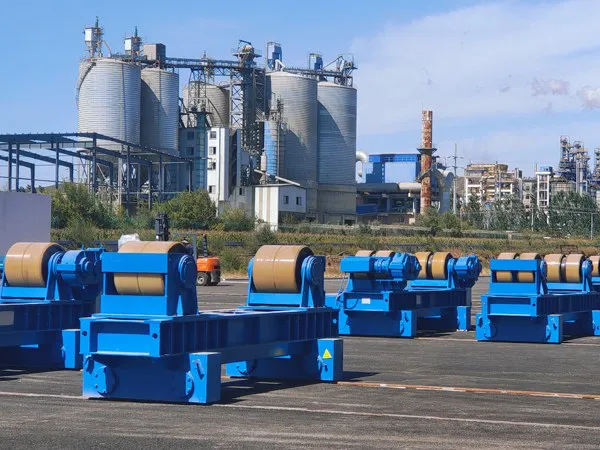Wind tower fabrication is a highly specialized and welding-intensive industry that relies heavily on automation due to the massive size and thick steel components involved. Rotadores de soldadura play a crucial role in this process by enabling precise and efficient welding of cylindrical wind tower sections.
Wind Tower Welding Rotator Welding Process
Here’s a breakdown of the welding process for wind tower welding rotators:

1. Wind Tower Fabrication Process (where rotators fit in):
Rollito de placa: Placas de acero grandes (often exceeding 80mm thick) are rolled into cylindrical “latas.”
Soldadura longitudinal: Individual cans are seam-welded along their length. This often involves manipulators and column-and-boom systems.
Circumferential Welding (where rotators are key): Once individual cans are formed, they are aligned and joined to each other with circumferential welds to form tower sections. This is the primary application for welding rotators. Rotators hold and rotate the heavy, cylindrical sections, allowing a stationary welding head (typically on a column and boom manipulator) to perform the circular weld.
Soldadura de brida: Flanges are attached to the ends of sections, also by circumferential welds, for on-site assembly.
Door Frame Welding: Door frames are welded, typically using mechanized flux-cored or metal-cored arc welding.
2. Key Welding Process for Wind Towers:
Soldadura de arco sumergido (SIERRA): This is the dominant welding process for both longitudinal and circumferential seams in wind tower fabrication.
High Deposition Rate: SAW can deliver extremely high weld metal deposition rates and the necessary heat for the thick steel used in wind towers.
Automatización: SAW is highly adaptable to automation, which is critical for consistent quality and productivity on large, repetitive welds.
Multi-wire SAW: To further increase productivity, multi-wire SAW systems (p.ej., twin arc, tandem arc, tandem twin arc) are commonly used, where multiple welding torches feed the same weld pool.
Flux Shielding: The arc is submerged under a blanket of granular flux, protecting the weld pool from atmospheric contamination. This also makes it less susceptible to environmental factors like wind.
Orientation: SAW typically requires gravity to hold the weld metal and flux in place, meaning the parts must be reoriented (p.ej., rotated by rotators) to maintain a flat or horizontal welding position.
Other Processes (for specific applications):
Gas Metal Arc Welding (GMAW or MIG) and Flux Cored Arc Welding (FCAW): Used for various applications, including door frame welding or in conjunction with SAW for certain passes.
Electrogas Arc Welding (EGW): A high-efficiency vertical automatic welding process used for thick plates, especially in offshore wind power generation facilities. A newer variant, SESLA, offers advantages like minimal spatter and fumes and excellent wind resistance.
Soldadura de brecha estrecha: Applied to reduce weld volume, utilizing special flat welding heads and single or tandem wire heads.

3. The Role of Welding Rotators:
Precise Rotation: Rotadores de soldadura (también conocido como rodillos giratorios) use wheels to align and rotate cylindrical workpieces, such as the “latas” of a wind tower, at a uniform and controlled speed.
Types of Rotators:
Conventional Rotators: Simple, sólido, and widely used for internal welding, long seam welding, tratamiento de superficie, and internal equipment installation.
….
More detailed information about what about the welding process for wind tower welding rotators can be clicked to visit: https://www.bota-weld.com/en/a/news/wind-tower-welding-rotator-welding-process.html


